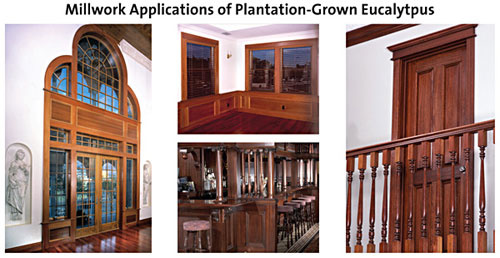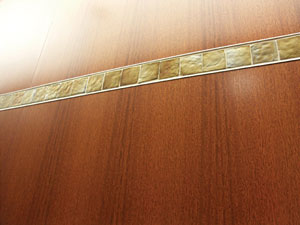Hardwoods in Green Building: Plantation-grown Eucalyptus Makes its Mark as a Versatile, Sustainable Exotic Species
Cabinets can be manufactured either from solid eucalyptus hardwood pieces or with veneers. Plantation grown eucalyptus is available as both flitches for custom applications and layons for plywood layup. Common characteristics of plantation-grown eucalyptus veneer are as follows:
Thickness: .6 mm (1/42 inch) and 1.6 mm (1/16 inch)
Width: 10 cm+ (3.9 inches +)
Length: 200 cm+ (78 inches+)
Grades: AA, A, B, C
Grain pattern: flat cut and quarters, with some specialty patterns available such as burl
 |
Photos and chart courtesy of Weyerhaeuser |
Â
 |
A consistent look was achieved with eucalyptus at Michigan State University�s Wharton Center for Performing Arts. Photo courtesy of TMP Architecture |
The machining and turning properties of plantation-grown eucalyptus enable it to be used for a wide range of millwork from stair parts to columns to wainscoting and other architectural finishing applications.
For its $18.5 million, 24,000-square-foot expansion and renovation, Michigan State University's Wharton Center for Performing Arts chose plantation-grown eucalyptus for several applications including its donor wall, wooden cases and all the wooden doors in the four-story building. Laura Casai, IIDA, LEED AP, Interiors, TMP Architecture in Bloomfield Hills, Michigan, explains that while the project did not go for LEED certification, it was certainly LEED inspired. "The owner was interested in being as environmentally responsible as possible without directly going for LEED. Eucalyptus was a perfect solution given its striking resemblance to cherry in its darker range, and its rapid growth cycle. Its roughly fifteen years cycle is just shy of the ten needed to be considered ‘rapidly renewable' by LEED, but it is close," says Casai. "It was an interesting material and easy to work with," says Casai, noting that she oversaw multiple suppliers for veneer and hardwood pieces. "There was quite a range of color to the wood, but we were able to achieve a very consistent look," she adds.
Sustainability of Eucalyptus Plantations
While there is enthusiasm for the physical characteristics of plantation-grown eucalyptus, there are differing schools of thought on the sustainability of the plantations. Critics contend that fast-growing tree plantations can be detrimental to the environment, maintaining that uniform stands of the same species, particularly non-native species, do not provide appropriate wildlife habitats and they diminish soil and water resources. On the other hand, studies by Aracruz Celulose, a Brazilian pulp producer, in conjunction with universities, research centers, non governmental organizations and environmental agencies both inside Brazil and internationally, have found that when professionally managed, a eucalyptus crop does not degrade the soil or impact its physical, chemical, and biological characteristics. Some experts also counter that when it comes to sustainability not all plantations are created equal, and that the merits of a plantation should be judged on a case-by-case basis, with plantation planning having the capacity to mitigate potential problems. For example, significant areas of native vegetation that provide habitat for native fauna can be retained in areas that are wet, steep or rocky, or otherwise not conducive to commercial tree growing, and linked to wildlife corridors to connect with native species on surrounding lands. In Australia, the Victorian Arthur Rylah Institute for Environmental Research is studying birds and mammals in eucalyptus plantations, and has found that these plantations can have a positive effect on conserving biodiversity that is higher than open farmland, though lower than native forest.
In Brazil, highly productive eucalyptus plantations are sometimes interspersed with reintroduced indigenous trees, all within larger areas of native forest preserve-a strategy that helps create and maintain biodiversity and preserve native ecosystems. In some cases, more than 30 percent of these plantations are managed as permanent native forest dedicated to environmental protection. Brazilian eucalyptus plantations are often located on what was originally Brazilian rainforest, but was deforested for agriculture up to one hundred years ago. In many instances, original species native to the area a century ago have been reintroduced into this ecosystem.
Although eucalyptus is considered to be a tree with high water demand, Aracruz studies conducted have shown that water consumption of the plantation-grown eucalyptus trees was similar to that of native forests. From 1998 to 2004, evapotranspiration (average water consumption by eucalyptus) was 1,092 mm/year (or liters/m2/year) which is similar to the average amount of rainfall (1,147 mm/year) and approximately the same average consumption of the native forests (1,167 mm/year). Studies of other crops such as coffee, sugarcane, and citrus fruits show similar water consumption to that of the eucalyptus trees in the study area.









